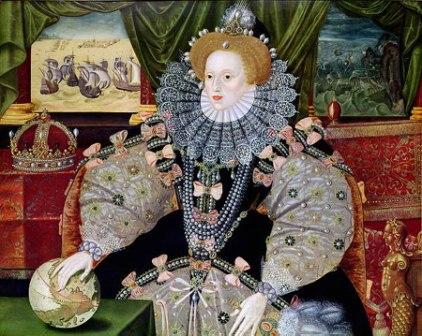 |
| Portrait of Princess Elizabeth Tudor, c.1546-47. Formally attributed to William Scrots. Picture acquired through Wikimedia Commons. Image public domain. |
The first portrait to be featured in our Bess to Impress series is the captivating portrait of Princess Elizabeth Tudor, aged about 13. The portrait is thought to have been painted between 1546 and 1547, and was formally attributed to William Scrots. Scrots flourished from 1537-53. Part of The Royal Collection, this stunning portrait can be viewed at Her Majesty Queen Elizabeth II's residence of Windsor Castle.
This portrait was a gift from Elizabeth Tudor to her brother, Edward VI. Depending on which date you subscribe to, Edward was either still a prince or recently crowned King of England when he received the portrait. In a letter accompanying the gift, Elizabeth wrote of her desire to see her brother, of whom she was very fond. The young Elizabeth uses a self-deprecating tone when she writes about her own face, though she speaks well of her intellect. Indeed, Queen Elizabeth, though very vain, never thought of her face as her best feature; instead she drew attention to her long, slender fingers, (so aptly on display in this portrait) and her neck, hair, and tiny waist. When her face became permanently scarred due to her bout with smallpox early in her reign, Elizabeth then did even more to draw attention away from her changed visage, wearing heavy white makeup and large, jewel encrusted gowns.
 |
| A detail of Princess Elizabeth from the 1546-47 portrait. Picture acquired through Wikimedia Commons. Image public domain. |
From a note accompanying the portrait, by the Princess Elizabeth to her brother, Edward VI:
'For the face, I grant, I might well blush to offer, but the mind I shall never be ashamed to present...when you shall look upon my picture you will witsafe to think that as you have but the outward shadow of the body before you, so my inward mind wisheth that the body itself were oftener in your presence.'
The young Princess, who had endured so much in her childhood and would suffer more injustice as a ward of her brother's uncle, Thomas Seymour, gazes back at the viewer intently, conveying with her eyes her wisdom beyond her years. I have discussed the portraits of Queen Elizabeth I with my dear friends Donna and Mia multiple times, and Donna and I are particularly moved by this portrait for the aforementioned reason. This portrait first resonated with me as a preteen when I was navigating a very dangerous childhood with my own father; seeing Elizabeth staring back at me from the pages of the Book Behind the Mask by Jane Resh Thomas, I immediately recognized a kindred spirit. It is a sober, haunting portrait which contrasts sharply with the glorious, triumphant portraits of Queen Elizabeth painted during her mid-to-late reign.
While not laden with symbolism like Elizabeth's portraits after she became Queen of England, this portrait displays a purposefully chosen accessory: books. The books emphasize Elizabeth's commitment to scholarly pursuits, a value that she shared with her brother, the portrait's recipient, and her piety. Perhaps it is a stretch to assume that the French style hood worn by Elizabeth Tudor is a nod to her mother, Anne Boleyn, (especially since the Princess Mary donned one in a portrait dated from about 1544) but given what we know about Elizabeth's defiant statement in the Whitehall Family Portrait, it is possible.
Other confirmed contemporary portraits of Princess Elizabeth from around this time include:
The Family of King Henry VIII/The Whitehall Family Grouping, c.1543-1547. By an unknown artist, after Hans Holbein. Part of The Royal Collection, this portrait can be viewed at Hampton Court Palace. To learn more about this portrait's significance to the Anne Boleyn/Elizabeth I connection, please see our article Death Could Not Separate Them: How Elizabeth I Connected to Her Deceased Mother.
 |
| The Children of King Henry VIII. Picture acquired through Wikimedia Commons. Image public domain. |
The Children of Henry VIII, c.1650-80, after a lost original from c.1545-1550. In the collection of the Duke of Buccleuch at Boughton House.
 |
| Elizabeth I as Princess, c.1550. Attributed to Levina Teerlinc. Picture acquired through Wikimedia Commons. Image public domain. |
Elizabeth I as Princess, c.1550. Portrait miniature attributed to female court artist to the Tudors, Levina Teerlinc.
There are also multiple woodcut style illustrations of the Princess Elizabeth in books and tracts that are not meant to be realistic, but rather depict scenes from her life.
Source:
Gittings, Clare. Portraits of Queen Elizabeth. London: National Portrait Gallery Publications, 2003.
Print.







